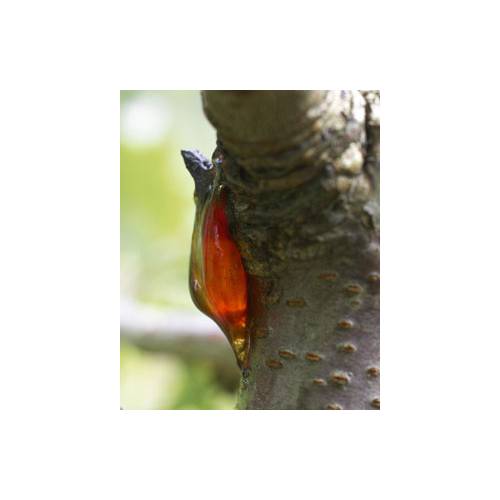
Diseases
Gum oozing
- Details
-
This illness is commonly called gummosis and is found in particular on fruit trees whose fruit has a stone (cherry, plum, apricot, peach, etc). It always attacks the heart of the trunk. It can be fatal to a young tree.
The symptoms
The disease drives its name from the principal symptom, the oozing of resin (gum) form along the trunk. This causes a split to develop in the bark, often where two branches join. This splitting open of the bark causes the gum to ooze out and not the other way round. In dry weather, the gum dries and hardens in a few weeks. In wet weather, the drying out process does not occur and the gum has a tendency to run down the length of the trunk taking on a rather unpleasant texture.
Lifecycle
The infection causing gummosis is always introduced by some type of small wound, like a badly healed pruning cut or a splitting of the bark following harsh frosts. The bacteria that cause the infection multiply in the tissue of the tree under the bark. In an attempt to defend itself, the tree starts to thicken the tissue around the infected wound, which causes the bark to split and gum to ooze out. As long as the tree is infected, the gum will ooze out as the tree continues to defend itself.
How to fight it
Gummosis occurs following the attack of bacteria on the tree, this must be combated. As there are no antibiotics for plants, the infection is best treated using bouillie bordelaise solution (containing copper salts that have an anti-bacterial action). You should spray the wound each month until it is healed. It is more effective to use an ointment on the wound, namely a coating of green clay mixed with bouillie bordelaise, applied using a paintbrush. Renew this application three times a year until it is healed. Sometimes it can take several years for complete healing.
How to avoid it
Coat your fruit trees’ trunks with lime in the autumn and at the end of the winter. This method of prevention will decrease the attacks. However, the best method for avoiding the need to fight this bacterial infection is to carefully choose where the trees are planted. Avoid areas where the soil remains damp through winter and the air is always humid, for example next to rivers and in valleys. Choose varieties that are naturally resistant, including those regularly grown in your locality. In any case, it is best not to try and grow a fruit type that is not suited to your region.
Good to know
NEVER remove the gum even if it is fresh or runs down the tree in wet weather. On the contrary, you should try to help it dry. The tree will reabsorb it once the infection is healed. - Photos (1)

